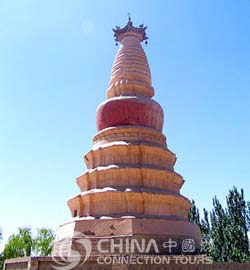 The White Horse Pagoda was built in Dunhuang in 386A.D, located on the outskirts of Dunhuang city, taking the advantage of its geographic location it became a major stop on Silk Road. The White Horse Pagoda has nine-storage, with a height of 12 meters and a width of 7 meters. It was made of adobes with a column inside and coated on the outside with mud and lime. The brick foundation is octagonal with a 3-meter wide face each. The 2-4th stories were shaped with overlapping refraction angles. The 1-5th stories were ringed with a line of pappilla spikes. The 6th story resembles an upside-down basin, and the 7th, a Buddhist wheel, while the 8th is sexangular with a wind bell hanging from each angle. The top story is a spire resembling a string of beads. The Pagoda on the whole is in the lamaist style of the Ming Dynasty.
The White Horse Pagoda was built in Dunhuang in 386A.D, located on the outskirts of Dunhuang city, taking the advantage of its geographic location it became a major stop on Silk Road. The White Horse Pagoda has nine-storage, with a height of 12 meters and a width of 7 meters. It was made of adobes with a column inside and coated on the outside with mud and lime. The brick foundation is octagonal with a 3-meter wide face each. The 2-4th stories were shaped with overlapping refraction angles. The 1-5th stories were ringed with a line of pappilla spikes. The 6th story resembles an upside-down basin, and the 7th, a Buddhist wheel, while the 8th is sexangular with a wind bell hanging from each angle. The top story is a spire resembling a string of beads. The Pagoda on the whole is in the lamaist style of the Ming Dynasty.
In fact, in the long history of Buddhism, along the Silk Road believers had built many temples and caves, in order to pay their respect to those monks who had dedicated their life to the spreading of the Buddhism. The White Horse Pagoda is just one of these buildings. Believers repaired the structure in every dynasty; therefore the White Horse Pagoda keeps its original beauty and always takes the lead among the tourist attractions in Dunhuang as is regarded as "scenery within the scenery".
People said that in North Liang period of the South and the North Dynasties (420~577A.D.), an Indian Buddhist master called Jumoloce riding a white horse with some scriptures came along the Silk Road to China to spread Buddhism. When he arrived in Dunhuang, his horse became ill and died. Jumoloce was very sad; he found a vacant land and buried the horse in Buddhist custom. Then he went on his journey eastward to preach and spread the Buddhism. Since that time, Buddhism became popular in Dunhuang. Local people later built a pagoda called the White Horse Pagoda near where Jumoloce buried his horse to commemorate this Buddhist Master.
There is also another story telling about the origin of the pagoda which found lesser favorable by many people. According to the novel "Pilgrimage to the West", the main character in the novel, Master Tang Xuanzang and three of his disciples were on their way to West Regions for scriptures of Buddhism had once stopped here. They encountered attacks by many monsters, but three disciples defeated all monsters. During the fights, the white horse sacrificed its life to save Master Tang Xuanzang. Later local people built the White Horse Pagoda to memorize them for their bravery.

